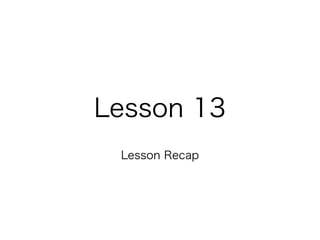
Lesson 13 Recap: Understanding Giving and Receiving in Japanese
- 1. Lesson 13 Lesson Recap
- 2. 1. Reviewing the giving and Receiving Japanese people like gifts One thing about Japanese culture is that they're big on giving gifts. There are many different customs involving giving and receiving gifts (お歳暮、お中元、etc.) and when oseibo ochuugen Japanese people go traveling, you can be sure that they're going to be picking up souvenirs to take back as gifts. Even when attending marriages or funerals, people are expected to give a certain amount of money as a gift to help fund the ceremony. You can see why properly learning how to express the giving and receiving of favors and items is a very important and useful skill. For some reason, the proper use of 「あげます」 and 「もらいます」 has always haunted people studying Japanese as agemasu moraimasu being horribly complex and intractable. I hope to prove in this lesson that it s conceptually quite straightforward and simple.
- 3. When to use あげます あげます is the Japanese word for "to give". You must use this verb when agemasu someone (as the giver) is giving something (as the object) to someone (as the receiver). The particle に is used to indicate to whom an object is delivered. Also ni when the subject of a sentence is the giver あげます is used. agemasu person(giver) は person(receiver) に Object を あげます。 wa ni o agemasu * ex. スミスさんは チャンさんに はなを あげました。 sumisu san wa chan-san ni hana o agemashita Mr. Smith gave Ms. Chan some flower. に *The verb あげます conjugates to the past form as あげました. agemasu agemashita
- 4. When to use もらいます もらいます is the Japanese word for "to receive". You must use this verb when moraimasu someone (as the receiver) is receiving something (as the object) from someone (as the giver). The particle に is used to indicate from whom an object ni is delivered. Also when the subject of a sentence is the receiver もらいます is moraimasu used. person(receiver) は person(giver) に Object を もらいます。 wa ni o moraimasu * ex. チャンさん は スミスさんに はなを もらいました。 chan-san wa sumisu-san ni hana o moraimashita Ms. Chan received some flower from Mr. Smith. に *The verb もらいます conjugates to the past form as もらいました. agemasu agemashita
- 5. Exercise 3 B) Ask and answer whom someone received something from. • Asking whom, you should use the question word だれ(dare) = who with a particle に(ni) . Subject(person) は だれ に Object を Verb (past) か。 wa dare ni o ka ex. A:スミスさんは だれに えいがの きっぷを もらいましたか。 sumisu san wa dare ni eiga no kippu o moraimashitaka B:チャンさんに もらいました。 chan san ni moraimashita
- 6. Exercise 3 C) Ask and answer what someone gave to another. • Asking what, you should use the question word なに(dare) = what with a particle を(o) . Subject(person) は another person に なに を Verb (past) か。 wa ni nani o ka ex. A:スミスさんは チャンさんに なにを あげましたか。 sumisu san wa chansan ni nani o agemashitaka B:えいがの きっぷを あげました。 eiga no kippu o agemashita
- 7. Exercise 4. You have to make up sentences or dialogues following the patterns of the examples and based on the information in the illustration. What you learn here in this exercise is adding a time expression as an event or an occasion in sentences, such as Christmas, Valentine s Day, and birthdays. • You should place a time expression right after the subject of the sentence with a particle に(ni) . Subject(person) は time expression に wa ni another person に Object を Verb (past) 。 ni o ex. :すずきさんは クリスマスに チャンさんに でんしじしょを s u z u k i s a n wa kurisumasu ni c h a n s a n n i denshijisho o あげました。 agemashitaka :チャンさんは クリスマスに すずきさんに でんしじしょを c h a n s a n wa kurisumasu ni s u z u k i s a n n i denshijisho o もらいました。 moraimashitaka
- 8. Exercise 4 D) Ask and answer when someone gave something to another. • Asking when, you should use the question word いつ(itsu) = when without any particle. Subject(person) は いつ wa another person に Object を Verb (past) か。 ni o ka ex. :すずきさんは いつ チャンさんに でんしじしょを あげましたか。 s u z u k i s a n wa itsu c h a n s a n ni d e n s h i j i s h o o agemashitaka Please follow appropriate rules with question words nani and dare for the rest of questions in the exercise.
- 9. あげます・もらいます の れんしゅう(1) agemasu moraimasu no renshuu 例(れい/rei) たかはしさん ・ささきさんは たかはしさんに プレゼントを ささきさん sasaki san wa takahashi san ni purezento o あげます。 agemashu ・たかはしさんは ささきさんに プレゼントを takahashi san wa sasaki san ni purezento o もらいます。 morai masu Note : the person who gives a hand is the giver ささきさん たかはしさん ささきさん たかはしさん たかはしさん たかはしさん たかはしさん たかはしさん ささきさん
- 10. あげます・もらいます の れんしゅう(2) agemasu moraimasu no renshuu You have just come back from a trip. Look at the picture and tell what you will give to the following people. Ex. : (わたしは)ちちに ウイスキーを あげます。 watashi wa chichi ni uisukii o agemasu (ルームメート) ruumu meito
- 11. あげます・もらいます の れんしゅう(3) agemasu moraimasu no renshuu Look at the picture and make sentences using もらいます. Ex. : (わたしは)かのじょに マフラーを もらいました。 watashi wa kanojo ni mafuraa o morai mashita (ビデオカメラ) bideo kamera
- 12. 「あげます」「もらいます」「くれます」の れんしゅう(4) agemasu moraimasu kuremasu no renshuu Describe who gave what to whom using あげます, もらいます, and くれます. Ex. : きょうこさんは ビルさんに セーターを あげました。 kyoko san wa biru san ni seetaa o age mashita Kyoko Mearii Biru Takeshi Ken Suu Naomi Robaato watashi
